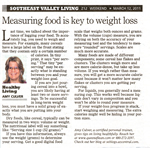 Measuring food is key to weight loss Measuring food is key to weight loss
Last time, we talked about the importance of logging your food. To accurately log, you need to weigh and measure. For example, many cereals have a large label on the front stating that they contain only a certain number of calories. In tiny print, it says "per serving." That tiny "per serving" may be exactly what is standing between you and your weight-loss goal.
If you are just pouring cereal into a bowl, you are likely having at least two or more servings. To be successful in long-term weight loss, you must have a solid grasp of exactly what you are putting into your body.
Dry foods, like cereal, typically can be measured in two ways: volume or weight. The nutritional label will say something like: "Serving size 1 cup (52 grams)."
If you have this information, always use the weight (grams) to determine your serving. Get a good digital food scale that weighs both ounces and grams. They are not expensive and are available at any home goods store. With the volume (cups) measure, you are relying on both the accuracy of your measuring tool and the tendency to measure "rounded" servings. Scales are much more accurate.
Many foods are made of different components; some cereal has flakes and clusters. The clusters weigh more and are more calorie-dense, but take up less volume. If you weigh rather than measure, you will get a more accurate calorie count because it won't matter how many flakes or clusters you are getting per serving.
For liquids, you generally need a measuring cup. This works well because liquids don't vary in composition and you won't be able to round your measure.
If your weight-loss progress is stuck, start weighing and measuring. The extra calories might well be hiding in your portion sizes.
|

